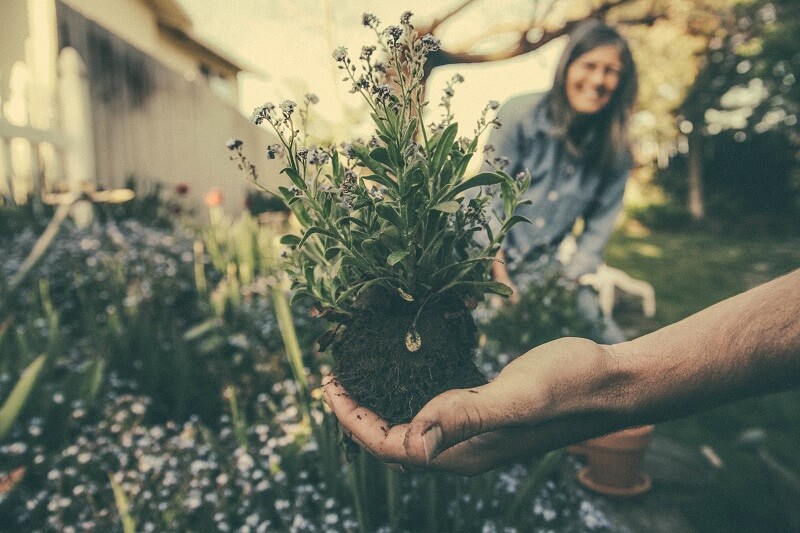
Tips for Preparing a Planting Bed
If you are preparing beds for landscaping around your house this article should simplify the process for you. I say that because of everything that is written about this subject, some of it is accurate, some of it is just plain wrong, and much of it is much more complicated than it needs to be. I like to think of myself as Simple Simon. I find the easiest, yet most effective way to do things, and they work.
Let’s assume that the area where you are planning your bed is now planted in grass. How do you get rid of the grass? Chemicals or no chemicals? Chemicals are easy, so we’ll look at the chemical method first.
My favorite chemical for killing grass and weeds is RoundUp, and used properly it is effective. Rule number one: Read the label on the package, and mix the chemical exactly as recommended by the manufacturer. Rule number two: Assume that every plant that the RoundUp touches is going to die. It is a non-selective herbicide.
The first thing you need to do is mark out where your planting bed is going to be. Spend some time on this step. If you are landscaping around your house, give careful consideration to what is going to be planted in the bed, and then decide how large each plant is going to be when fully mature.
You can keep plants trimmed to a certain size, but be realistic when you make these estimates. Trust me when I tell you, this is the number one mistake made by Do-it-Yourself landscapers. People are just afraid to make those beds large enough.
Typically, a bed should never be narrower than 42”, and corner beds should be 12’ in diameter. Islands. If you make those little tiny island beds that I see everywhere I am going to come over to your house and snap you with a wet towel! The island bed in your front yard should be 20’ to 40’ long, and a minimum of 12’ in diameter on at least one end.
The easiest way to mark out your planting beds is to buy a can of marking paint at the hardware store. Unlike most spray paint, this only works when the can is inverted, and it is designed specifically for painting lines on the ground. They even have cans that spray chalk instead of paint. I’ve always used the paint, it holds up better if it gets wet.
Once you have the outline of the bed established and marked, mix up some RoundUp and spray all the grass and weeds inside the bed area. Do not put RoundUp in a sprayer that you intend to use for other purposes. You need a sprayer that is dedicated for the use of herbicides. When applying the spray, be very careful not to let the spray drift onto the grass and other plants that you do not want to kill.
To minimize spray drift, adjust the spray nozzle so the spray pattern is narrow and the droplets are larger. A wide, fine spray pattern is sure to drift outside of the intended area. Also keep the pressure in the sprayer quite low. Pump it just enough to deliver the spray. High pressure causes the spray to atomize and drift. Apply just enough spray to wet the foliage. If you have liquid dripping off the blades of grass, you are applying too much. More is not better.
Once sprayed, be careful not to step in the area that has been sprayed. Many people have had golden footprints across their lawn because they forgot and walked through what had been sprayed.
This is the difficult part, and the part that many people do not get, so pay close attention. The only way that the RoundUp can possibly work is if you leave it alone. Did you get that? Once you apply the RoundUp, don’t do another thing with that bed for 72 hours. That’s three very long days. I know you’re anxious, but this is the price you pay for not planning ahead.
RoundUp is a systemic herbicide, which means that it has to be absorbed by the plant, then translocated throughout the plant. It takes three days for that to happen. If you go digging and chopping, you might just as well skip the spraying step. Go build a compost bin while you’re waiting.
After three days the weeds and grass are going to look as healthy and happy as ever. Don’t let ’em fool ya. They’re as dead as dead can be. Providing the RoundUp didn’t get washed off by rain within the first 24 hours of the waiting period. Now you can dig and chop to your heart’s content.
However, the only digging that I do is to go around the edge of the bed and strip the sod back about 15”. Just peel off about 1” and flip it into the center of the bed. This makes it easier to edge and mulch the bed if you get the sod out of the way. Now for the non- chemical method.
Mark out the outline of the bed as described above. Strip the sod back 15”, just like above. Since you aren’t using any herbicides I would dig down about 1-1/2” when removing the sod from the edges. Take the sod you stripped back and lay it in the center of the bed upside down and pack it down firmly. Now take newspaper or brown paper grocery bags and cover the entire bed area. Use 9 layers of newspaper. No matter what method you used, chemical or non chemical, you are now ready to fill the planting bed with topsoil.
Put 8 to 12” of good rich topsoil in the bed. Make sure the soil is higher in the back, closest to the wall, so the water drains away from the building. If you are creating an island planting make the center of the bed the highest point. Make sure the topsoil you buy is well drained and rich in organic matter. Buying topsoil is a tricky game, you’ve got to be careful and shop around. Topsoil is one item that you do not want to order over the phone, sight unseen.
This is what you are looking for when buying topsoil:
Topsoil that is rich in organic matter will be very dark in color. If the soil is light in color it is probably just fill sand. The other thing you’ve got to watch for is how well drained the soil is. Topsoil that has a clay base is poorly drained and sticky, and your plants will not be happy at all. They might even die if they are too wet. Once a clay based topsoil dries out it gets very hard.
Today most topsoil is run through a screener to remove the clumps, rocks, roots, and sticks. There is nothing wrong with buying unscreened topsoil, especially if you’ve visually inspected it and have found it to be of good quality. Actually, really good topsoil shouldn’t have to be screened, but there is little of that quality topsoil to be had.
When you visit the yard where the soil is stockpiled, scoop up a handful of the topsoil and run it through your fingers. If it seems to be grainy, it is probably good soil. But if it appears to be tiny round balls that can be smashed between your fingers, it is probably a clay based soil that will trap water during rainy seasons, and get as hard as a rock when it’s hot and dry.
Pay attention to how the soil is screened. Some machines just shake the soil over a set of screens to separate the debris, and others actually shred the soil. If the soil needs to be shredded, you don’t want it. Look closely at the pile that the raw soil is coming from. If the soil in the raw pile is as hard as a rock, that’s what the screened soil is going be once you get it in your beds. If it appears to be fairly loose, it’s probably good soil.
Put 6-8” of topsoil in your beds. You are now ready to plant. Did you notice that I didn’t get into rototilling and all kinds of extra work? Nor did I suggest that you add bone meal or any of those other goodies that the garden centers sell. I skipped the part about checking the pH too. pH is important, but I’ve found that good topsoil almost always has a suitable pH.
I’ve got a confession to make. In almost 30 years of growing, planting, landscaping and the like, I’ve never tested the pH of the soil on any project that I was working on. Is that smart? I don’t know, but I’ve been successful in my efforts, and I have landscaped several hundred homes and grown tens of thousands of plants.
It’s something to think about. What I’m really trying to say is don’t get caught up in too many details, and be careful who you take advice from at those garden stores. Many of those sales people were flipping burgers last week.
To see the rental equipment in Milton or Crestview, FL click here
